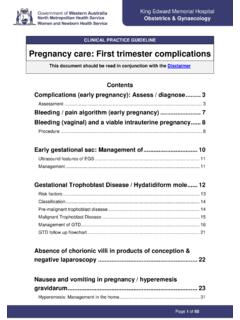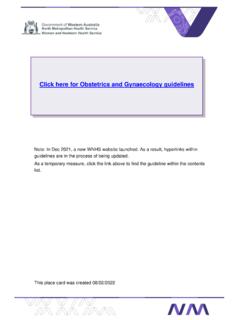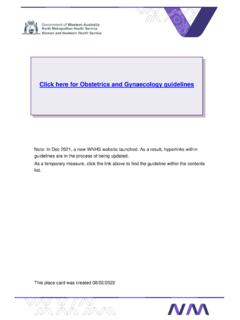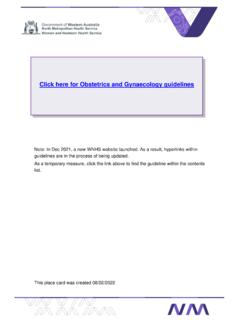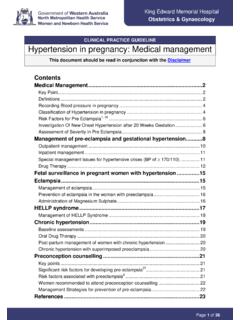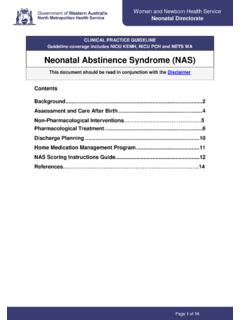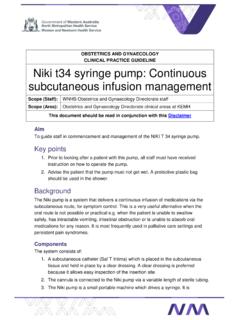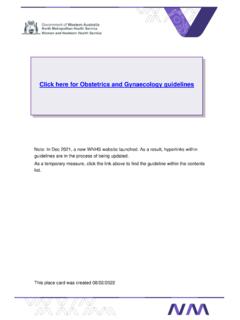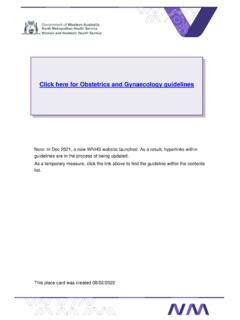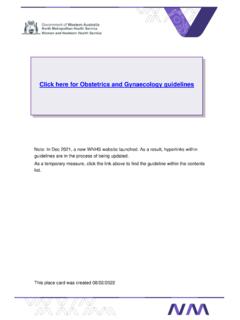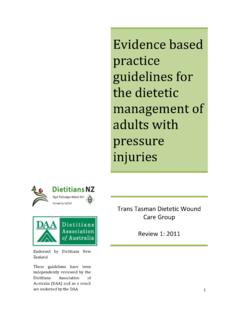Transcription of Skin Care Guidelines - kemh.health.wa.gov.au
1 Women and Newborn Health Service Neonatal Directorate CLINICAL PRACTICE GUIDELINE. Guideline coverage includes NICU KEMH, NICU PCH and NETS WA. Skin care Guideline This document should be read in conjunction with the Disclaimer Table of Contents Key Points . 2. Skincare Practices in the NICU 2. Neonatal Skin Condition Score Tool .. 3. Glamorgan Pressure Injury Risk Assessment . 4. Wound Management .. 5. Nappy Rash/Perineal Excoriation .. 6. Neonatal Skin care Quick Reference Guide . 7. References 9. Appendix Pressure Relieving Devices 11. Page 1 of 11. Skin care Guidelines Key Points All infants admitted to the NICU must have both a skin assessment condition score, and a pressure injury risk assessment score completed once per shift. Use the Neonatal Skin Condition Score (NSCS)1,2 and the modified Glamorgan Scale (GS)3 for pressure injury assessment. NSCS: An assessment is to be documented within the first 4 hours of admission.
2 Then assess with the first all cares' each shift and document on the Neonatal Observation Chart (MR489/491) in the comments section. GS: Document the GS score on the Neonatal Observation Chart (MR489/491) in the comments section at change of shift handover with other checks (ID, emergency preparedness equipment). When performing skin assessments ensure adherence to standard infection control measures to reduce transmission of infection (hand hygiene, environmental cleaning). Be aware of and identify infants with environmental, treatment or management factors that may alter skin integrity Be aware of and identify infants with risk factors for pressure injury from unrelieved pressure over bony prominences/dependent body parts and monitoring/medical devices. In the event of skin breakdown commence a Wound Assessment and Management Tool (MR492 and document in the progress notes. In the event of a pressure injury, a Pressure Injury Alert sticker is to be completed and placed in the progress notes.)
3 A Neonatal Wound Assessment and Management Tool (MR 492) is to be commenced and CNC notified. Skincare Practices in the NICU. All infants are prone to developing skin injury or immobility-related pressure injury from medical devices. This is due to unrelieved or excessive pressure on dependent body parts, especially bony prominences5; prematurity (limited subcutaneous fat, underdevelopment of epidermis and dermis), and/or medical condition that restricts repositioning schedules and options1,6. It is essential to perform and document an assessment of every infant's skin integrity on admission and for each day of their hospital stay7. Routine hygiene is attended as per the care , Hygiene and Clothing guideline, this includes minimal cleanse, bathing and/or the use of anti-staphylococcal treatment for infants at risk. Coconut Oil is to be used to maintain and improve skin integrity in preterm infants born <30 weeks gestation, and continued until 37 weeks corrected gestational age or discharge from the unit.
4 Refer to Coconut Oil policy. All health care professionals are responsible for maintaining an infant's skin integrity and for the prevention, identification, treatment and documentation of pressure injury due to medical devices for the infants in their care . Using a Skin Assessment Tool1 and a Pressure Injury Risk assessment Tool for routine assessment may promote consistency in scoring and in recognising skin problems1,8. Prevention of pressure injury is incorporated into all NICU Guidelines (see Neonatal Skin care Quick Reference Guide below). Trigger factors1,5,9 should be taken into account when performing assessments: Neonatal Directorate Page 2 of 11. Skin care Guidelines Neonatal Skin Condition Score Tool Neonatal Skin Condition Score (NSCS). DRYNESS ERYTHEMA BREAKDOWN. 1 normal, no sign of dry 1 no evidence or 1 none evident skin erythema 2 dry skin, visible 2 visible erythema, 2 small, localized areas scaling <50% body surface 3 very dry skin, 3 visible erythema, 3 extensive cracking/fissures 50% body surface Score 1-3 for each category: Perfect Score = 3, worst score = 9.
5 (This tool is designed to facilitate assessment of skin condition. It is copyright of Association of Women's Health, Obstetric and Neonatal Nurses (AWHONN) and was developed for the AWHONN/NANN Neonatal Skin care Research-Based Practice Project (2007) and is reproduced with their kind permission). Glamorgan Pressure Injury Risk Assessment (Modified). Performing regular assessments identifies infants at high risk and early detection of pressure injury. Omission of a daily pressure injury assessment can lead to poor detection of risks associated with hospitalisation resulting in an inadequate level of risk identified. NSQHS Standard 8 - Prevention and Management of Pressure Injuries specifies the need for the use of screening tools and risk assessment frameworks. Application of reliable risk assessment tools provides a useful means for identification of at-risk infants so that appropriate and timely prevention strategies can be implemented.
6 Pressure from medical devices and the degree of immobility are the 2 key trigger factors which place infants at risk3,10. Assess using the GS and document the total score; however scores for individual risk factors should also be acted on. Most infants admitted to NICU will score 10. or higher therefore the risk of developing pressure injuries should not be underestimated and action should be taken to prevent any This action may include normal nursing care , such as frequent changes of position (document how often position is changed), lying the infant on a sheepskin, gel mattress or on an air-filled mattress. Changing the position of pulse oximeter probes and other monitoring devices regularly, ensuring the infant is not lying on objects in the bed such as cables, tubing or monitoring devices. See Neonatal Skin care Quick Reference Guide for recommended nursing care . Neonatal Directorate Page 3 of 11. Skin care Guidelines Glamorgan Scale Assesses Risk For Pressure Injury It is not necessary to disturb the baby to calculate the GS.
7 Write score on observation chart under comments section. Trigger (Risk) Factors Risk Assessment Score GA <32 weeks 1. Infant cannot be moved without great Vascular compromise or poor tissue difficulty or deterioration in condition (a perfusion (HIE, Cooling, inotropes). ventilated infant who de-saturates 20. with position changes or in certain Impaired neurological or sensory positions. Poor peripheral perfusion: perception. cold extremities, capillary refill > 2. Immobility due to illness and/or sedation, seconds / cool mottled skin). muscle relaxation. 2. Infant unable to change his/her position Sepsis, dehydration, oedema. without assistance/reduced body Ventilation - ETT and nasal CPAP. movement (an infant may be unable 15. Surgery. to move themselves, but carers can move the infant and change his/her Monitoring devices/Cables/Leads position without deterioration in vital ETT, nasal CPAP, HHF, PBF signs). TCM, Sa02, ECG leads, temp probes.
8 3. Some mobility, but reduced for age Medical taping (IV lines/splints, gastric (infant has some ability to change their 10. tubes, phototherapy eye pads) own position but this is limited /. Mattress surface restricted (infants on CPAP, nested, IV. splints & fluids). 4. Normal mobility for age 0. 5. RISK ASSESSMENT of equipment / objects / hard surface pressing or rubbing on skin. This is either yes' or no' (most will score yes' so 15). Any object pressing, rubbing or taped on the skin for long enough or with enough force can cause pressure damage if not removed as per suggested action below. 15. Infants scoring 20 in the above risk assessment are particularly at risk. ACTION TAKEN Total score Ensure plan of care is implemented / reviewed as per Neonatal Skin care Max 35. Quick Reference Guide (add score from 1- 4 plus Commence Wound Assessment and Management Plan MR492 if there are score from 5). any areas of concern.)
9 Neonatal Directorate Page 4 of 11. Skin care Guidelines Risk Category Suggested action following Glamorgan Pressure Injury Risk score Assessment (Neonatal Skin care Quick Reference Guide). 0 Not at risk Continue to reassess daily and every time condition changes. 10+ At risk Inspect skin at least twice a day. Relieve pressure by repositioning at least every 2-4 hours. Use a size and weight appropriate pressure redistribution surface if necessary. Re-site monitoring devices 2-4. hours. 15+ High risk Inspect skin with each repositioning. Reposition infant / equipment/. devices at least every 2- 4 hours. Relieve pressure before any skin discolouration develops. Use a size and weight appropriate pressure redistribution surface. 20+ Very high Inspect skin at least hourly if condition allows. Move or turn if possible, risk before skin becomes discoloured. Ensure equipment / objects are not pressing on the skin. Reposition equipment / devices at least every 2.
10 Hours if condition allows. Consider using specialised pressure relieving equipment if unable to reposition. Pressure Injury Relieving Equipment Refer to Appendix 1. Pressure Injury On detection of any pressure injury a Pressure Injury Alert sticker is to be completed and placed in the progress notes. A Wound Assessment and Management form MR. 492 is also to be commenced. Wound Assessment and Management Tool On detection of any skin breakdown or pressure injury the following steps should be followed. Identify the causative factors, aetiology device (CPAP prongs, saturation probe), decreased mobility (sedated, muscle weakness) or poor tissue perfusion (extreme prematurity, cooling). History and duration of injury if known. Check pain score and consider pain relief. Continue pain assessment until pain resolved. Inform Coordinator, Medical team and CNC. Complete a Neonatal Wound Assessment and management Plan MR492 and formulate a plan for the management of the wound and a dressing if needed - in conjunction with appropriate team Stoma Therapist, Plastics or Surgical Team.
